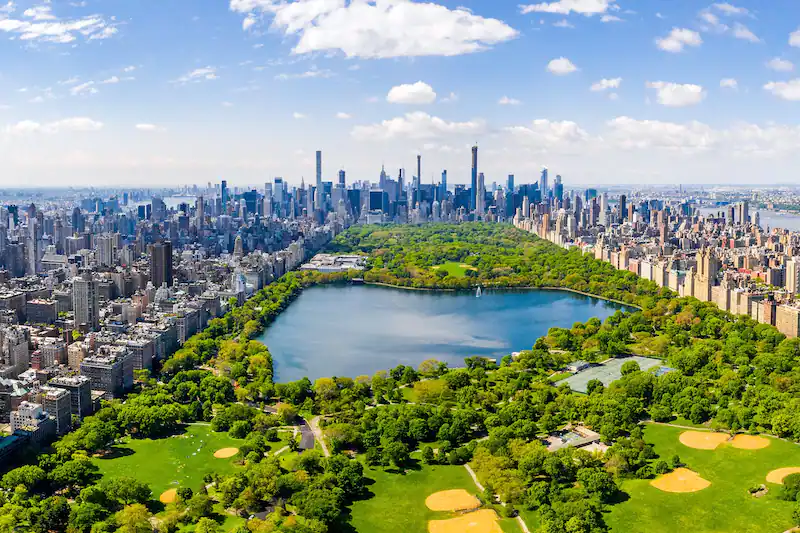Have you ever wondered why certain cities become symbols of environmental cleanliness and safe living? What efforts and initiatives allow them to remain at the top of the world rankings? And most importantly, what environmental initiatives are supported by the majority of their population? Now we will try to find answers to these questions, based on examples of such megacities as:
- Oslo
- Hague
- Tokyo
- NY
- Copenhagen
- London
Let’s look at what exactly makes these cities environmentally friendly and what efforts they make to maintain the natural environment and ensure the comfort of their residents.
Oslo (Norway)
As you know, Oslo, the capital of Norway, is considered one of the most environmentally friendly cities in Europe. This is facilitated by a number of successful environmental initiatives being implemented in the city. In Oslo, the construction of energy-efficient houses is actively developing, the number of cars on the roads is decreasing, and bees are even bred on the roofs of some buildings.
However, that’s not all. Evening Oslo is lit with highly efficient high-pressure sodium lamps, saving energy and reducing greenhouse gas emissions. In addition, the city has special tolls aimed at reducing the number of cars on the streets.
A big part of Oslo’s success is its Energy from Waste program, which generates energy from recycling more than 70% of its waste. These efforts make Oslo environmentally sustainable and an inspiring example for other cities around the world.
The Hague (Netherlands)
One of the largest cities in the Netherlands is proud of its green taxi service. The entire fleet consists exclusively of electric vehicles, which helps reduce emissions of harmful gases into the atmosphere. Visitors, as tourists, have the opportunity to call a taxi by phone, simply raise their hand on the street and hail a green taxi, or even book a full tour of The Hague using these eco-friendly cars.
Tokyo (Japan)
In the past, especially in the 50s to 70s, Japan suffered from serious environmental problems and was considered one of the most polluted countries in the world. However, in modern times, Japan can confidently be called a country of ecology. Over the past decades, it has successfully implemented various environmental initiatives aimed at protecting the environment.
An example of such initiatives is the efficient water supply system used in the capital of Japan, Tokyo. It is based on the latest technologies and modern methods for monitoring emergency situations, which can significantly reduce possible water losses in the city. In addition, the Department of Environment of the Tokyo Government organizes regular free educational courses on urban planning based on the principles of sustainable development, biodiversity and green energy use.
These measures have made Japan a model country in the field of environmental protection and serve as an example for many other countries seeking to improve their environmental conditions.
New York (USA)

On July 1, 2015, a law prohibiting the use of polystyrene foam came into effect in New York City and the state of the same name. This law applies to all food service establishments that previously used disposable foam containers for food packaging, product delivery, in-store packaging, and other purposes. Thus, New York became the largest city in the United States to support and implement this initiative.
Copenhagen (Denmark)
Back in the 1960s, the roads of Copenhagen, the capital of Denmark, were crowded with cars, which polluted the air with large amounts of gas emissions. However, today Copenhagen can be called one of the most comfortable cities to live in. Here, much attention is paid to pedestrian and bicycle zones, which replace automobile roads.
Moreover, the city government has announced its ambitious goal of making Copenhagen the world’s first carbon-neutral city by 2050. Active steps are being taken in this direction to improve the environmental situation. In addition, there is a law that requires the level of landscaping to be taken into account when constructing new buildings. This has led to the creation of mini-parks and gardens on the roofs of many buildings in the city, where residents and visitors of the city can enjoy nature and fresh air.
London, (Great Britain)
The capital of Great Britain and the birthplace of Shakespeare, London, is actively implementing environmental initiatives aimed at reducing harm to the environment. For example, the city hall has implemented strict environmental standards for all cars in the city center. This means that cars that do not comply with Euro 4 (petrol) and Euro 6 (diesel) standards are required to pay an additional fee of between 15 and 116 euros per day, depending on the size of the car.
In addition, disused London Underground lines have been converted into underground routes for pedestrians and cyclists, helping to reduce traffic congestion and improve travel safety for residents. These initiatives are helping to make London a greener and more environmentally friendly metropolis.
Research by our public organization on urban cleanliness is a key part of our work. We strive to ensure that every city becomes a place where clean air, fresh water and healthy nature are available to all its residents.
Our environmental experts examine various aspects of the urban environment, including air quality, water and green areas, pollution levels and many other parameters. We analyze data and identify problem areas where it is necessary to take measures to improve the environmental situation.
Our research not only helps identify problems, but also offers concrete recommendations and solutions for improving the environment in cities. We believe that clean cities are key to the health and well-being of their residents, and we work hard to make every city cleaner and greener.

